Borzoi
The Borzoi[lower-alpha 2] is a large breed of dog of sighthound type originating from Russia. Historically, the breed has been used for wolf hunting and until 1936 the breed was known as the Russian Wolfhound.[1][2]
| Borzoi | |||||||||||||||||||||||||||||||||
|---|---|---|---|---|---|---|---|---|---|---|---|---|---|---|---|---|---|---|---|---|---|---|---|---|---|---|---|---|---|---|---|---|---|
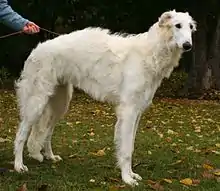 A Borzoi | |||||||||||||||||||||||||||||||||
| Other names |
| ||||||||||||||||||||||||||||||||
| Origin | Russia | ||||||||||||||||||||||||||||||||
| |||||||||||||||||||||||||||||||||
| |||||||||||||||||||||||||||||||||
| Dog (domestic dog) | |||||||||||||||||||||||||||||||||
Etymology
The system by which Russians over the ages named their sighthounds was a series of descriptive terms, not actual names. Borzói is the masculine singular form of an archaic Russian adjective that means 'fast'. Borzáya sobáka ('fast dog') is the basic term for sighthounds used by Russians, though sobáka is usually dropped. The name psovaya derived from the word psovina, which means 'wavy, silky coat', just as hortaya (as in hortaya borzaya) means shorthaired. In modern Russian, the breed commonly called the Borzoi is officially known as russkaya psovaya borzaya. Other Russian sighthound breeds are stepnaya borzaya (from the steppe), called stepnoi; and krimskaya borzaya (from the Crimea), called krimskoi.[3]
The most commonly used plural form is the regular formation Borzois, which is the only plural cited in most dictionaries.[4][5] However, the Borzoi Club of America and the Borzoi Club UK[6] both prefer Borzoi as the form for both singular and plural forms.
History
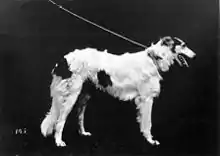
_Wolf_hunt_with_borzois.jpg.webp)
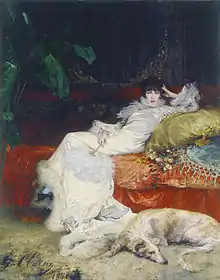
The Borzoi originated in 16th century Russia by crossing Persian greyhounds and European sighthounds with thick-coated Russian breeds.[7][8]
The more modern Psovaya Borzaya was founded on Stepnaya, Hortaya and the Ukrainian-Polish version of the old Hort. There were also imports of Western sighthound breeds to add to the height and weight. It was crossed as well with the Russian Laika specifically and singularly to add resistance against Northern cold and a longer and thicker coat than the Southern sighthounds were equipped with.[9]
All of these foundation types—Tazi, Hortaya, Stepnaya, Krimskaya, and Hort—already possessed the instincts and agility necessary for hunting and bringing down wolves.
The Borzoi was popular with the Tsars before the 1917 revolution. For centuries, Borzoi’ could not be purchased but only given as gifts from the Tsar. Grand Duke Nicholas Nicolaievich of Russia bred countless Borzoi at Perchino, his private estate.[10]: 10 [11]
The Russian concept of hunting trials was instituted during the era of the Tsars. As well as providing exciting sport, the tests were used for selecting Borzoi breeding stock; only the quickest and most intelligent hunting dogs went on to produce progeny. For the aristocracy these trials were a well-organized ceremony, sometimes going on for days, with the Borzois accompanied by mounted hunters and Foxhounds on the Russian steppe. Hares and other small game were by far the most numerous kills, but the hunters especially loved to test their dogs on wolf. If a wolf was sighted, the hunter would release a team of two or three Borzois. The dogs would pursue the wolf, attack its neck from both sides, and hold it until the hunter arrived. The classic kill was by the human hunter with a knife. Wolf trials are still a regular part of the hunting diploma for all Russian sightdog breeds of the relevant type, either singly or in pairs or trios, in their native country.
After the 1917 Revolution, wolf hunting with sighthounds soon went out of fashion as an "aristocratic" and a means- and time-consuming way of hunting[11].A necessity in a wolf-catching sighthound didn't exist, in addition to the old proved technique of battue with the use of baits, flags and other appeared new, way more effective—from airplanes, from propeller sleighs, with electronic lure whistles. For decades the generations of few remaining sighthounds were regarded as hunting-suited, when showing enough attacking initiative for fox hunting. The rumours about persecution of sighthounds in post-revolutionary Russia are a legend of modern times, possibly based on similar incidents in Maoist China.
In the late 1940s, a Soviet soldier named Constantin Esmont made detailed records of the various types of Borzoi he found in Cossack villages. Esmont was concerned that the distinct types of borzaya were in danger of degenerating without a controlled system of breeding. He convinced the Soviet government that Borzois were a valuable asset to the hunters who supported the fur industry and henceforth, their breeding was officially regulated. To this day short-haired Hortaya Borzaya are highly valued hunting dogs on the steppes, while the long-haired Psovaya Borzaya, is going through a hard period of restoration of its working qualities after decades of shadow, mainly show existence.
Exports of Borzois to other countries were extremely rare during the Soviet era. However, enough had been taken to England, Scandinavia, Western Europe, and America in the late 19th century for the breed to establish itself outside its native country.
Description
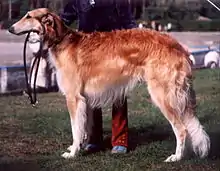
Appearance
Borzois are large Russian sighthounds that resemble some central Asian breeds such as the Afghan hound, Saluki, and the Kyrgyz Taigan. Borzois come in virtually any color.[12] The Borzoi coat is silky and flat, often wavy or slightly curly. The long top-coat is quite flat, with varying degrees of waviness or curling. The soft undercoat thickens during winter or in cold climates, but is shed in hot weather to prevent overheating. In its texture and distribution over the body, the Borzoi coat is unique. There should be a frill on its neck, as well as feathering on its hindquarters and tail.[13][14]
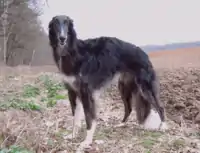 Black Borzoi
Black Borzoi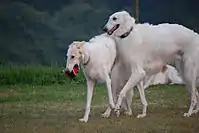 Yellow and white, and white Borzois
Yellow and white, and white Borzois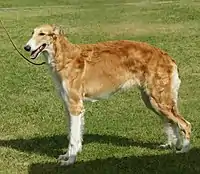 Red and white Borzoi
Red and white Borzoi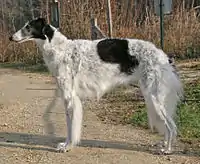 Black and white Borzoi
Black and white Borzoi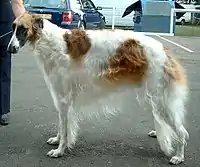 White and brown Borzoi
White and brown Borzoi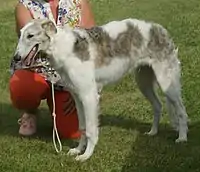 White and grey Borzoi
White and grey Borzoi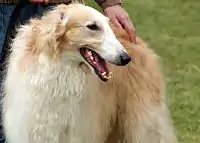 Borzoi, white and sandy coloured coat
Borzoi, white and sandy coloured coat
Temperament
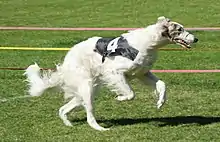
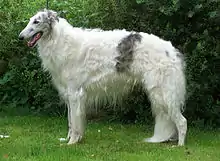
The Borzoi is an athletic and independent breed of dog with a calm temperament.[1]
In terms of obedience, Borzois are selective learners who quickly become bored with repetitive, apparently pointless activity, and they can be very stubborn when they are not properly motivated. For example, food rewards, or "baiting", may work well for some individuals, but not at all for others. Nevertheless, Borzois are definitely capable of enjoying and performing well in competitive obedience and agility trials with the right kind of training.[10]: 113 [15][16][17]
Health
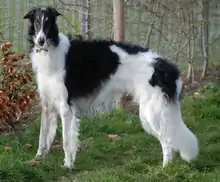
Stated life expectancy is 10 to 12 years.[18][19] Median lifespan based on a UK Kennel Club survey is 9 years 1 month. 1 in 5 died of old age, at an average of 10 to 11.5 years. The longest lived dog lived to 14 years 3 months.[20] Dogs that are physically fit and vigorous in their youth through middle age are more vigorous and healthy as elderly dogs, all other factors being equal. In the UK, cancer and cardiac problems seem to be the most frequent causes of premature death.[21]
As with other very deep-chested breeds, gastric dilatation volvulus (also known as bloat) is the most common serious health problem in the borzoi. This life-threatening condition is believed to be anatomical rather than strictly genetic in origin. One common recommendation in the past has been to raise the food bowl of the dog when it eats. However, studies have shown that this may actually increase the risk of bloat.[22]
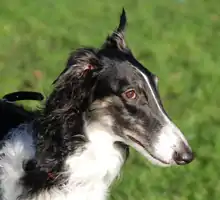
Notes
References
| Wikimedia Commons has media related to Borzoi. |
- "Borzoi". American Kennel Club. Retrieved 29 November 2018.
- Sabaneev L.P. (1993). Hunting dogs: borzois and hounds (in Russian). Moscow: Terra Publishing. p. 571. ISBN 5-85255-188-0.
- Сабанеев, Леонид (2 December 2021). Собаки охотничьи. Борзые и гончие (in Russian). Litres. ISBN 978-5-04-333011-6.
- "Borzoi". Dictionary. Retrieved 26 April 2014.
- "Definition of Borzoi in Oxford dictionary (British & World English)". Oxford dictionary. Retrieved 26 April 2014.
- "theborzoiclub.org.uk". theborzoiclub.org.uk. Retrieved 26 April 2014.
- "Borzoi | Breeds A to Z | The Kennel Club". www.thekennelclub.org.uk. Retrieved 29 April 2022.
- Martin, Nellie (2005). Borzoi - The Russian Wolfhound. Its History, Breeding, Exhibiting and Care. Vintage Dog Books. ISBN 1846640423.
- Animal-World. "Borzoi". Animal World. Archived from the original on 1 June 2018. Retrieved 1 June 2018.
- Desiree Scott (2002). Borzoi. Dorking, Surrey: Interpet Publishing. ISBN 9781903098936.
- Kalamaras, G. (2019). "For All the Russian Wolfhounds—the Borzoi—Slaughtered During the Revolution, 1917". Undocumented: 156–157. doi:10.14321/J.CTVJSF4HW.90. ISBN 9781609175870. S2CID 198844826.
- "Borzoi Colors and Markings". American Kennel Club. Retrieved 19 March 2012.
- "The Borzoi Standard". Borzoi Club of America. Archived from the original on 7 March 2012. Retrieved 19 March 2012.
- Mischiha O. "Russian Borzoi". My Friend: The Dog. 2013: №1: 10–17.
- Brunarski/Moyer. "lyric". Nktelco.net. Retrieved 23 May 2012.
- "Borzoi Club of America, Inc". Borzoiclubofamerica.org. Archived from the original on 29 February 2012. Retrieved 23 May 2012.
- М, Венцеславский А. (14 March 2013). Псовая охота вообще (in Russian). Directmedia. ISBN 978-5-4460-1839-0.
- "NZKC – Breed Standard – Borzoi". New Zealand Kennel Club. Retrieved 3 November 2011.
- "Borzoi: Dog Breed Selector: Animal Planet". Animal Planet. Retrieved 3 November 2011.
- "Individual Breed Results for Purebred Dog Health Survey". Archived from the original on 13 August 2013. Retrieved 27 June 2012.
- Archived 14 February 2012 at the Wayback Machine
- Glickman L, Glickman N, Schellenberg D, Raghavan M, Lee T (2000). "Non-dietary risk factors for gastric dilatation-volvulus in large and giant breed dogs". J. Am. Vet. Med. Assoc. 217 (10): 1492–9. doi:10.2460/javma.2000.217.1492. PMID 11128539. S2CID 22006972.
Further reading
- Chadwick, Winifred E. (1952). The Borzoi Handbook. London: Nicholson & Watson. Including a translation of The Perchino Hunt by His Excellency Dmitri Walzoff (1912).
- Martin, Nellie L. (2005). Borzoi—The Russian Wolfhound: Its History, Breeding, Exhibiting and Care. Read Books. ISBN 978-1-84664-042-1.
- McRae, Gail C. (1989). Borzoi (New ed.). TFH Publications. ISBN 978-0-86622-676-9.
- Savenkova, V. (2003). Russkaya Psovaya Borzaya. Moscow. ISBN 978-5170169740.